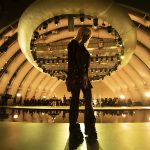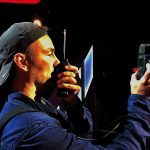For the past six years, Black Girls Rock, Inc., an organization that promotes empowerment and mentoring for young women of color through the arts, has partnered with BET Networks to broadcast their annual awards event. The Black Girls Rock! production is an inspiring evening of performances, awards, speeches, and celebration. The 2016 show included appearances by Lauryn Hill, Gladys Knight, Brandy, Corrine Bailey Rae, Rihanna, Monica, Shonda Rhimes, Danai Gurira, and Hillary Clinton.
The event has become a much anticipated annual project for the show’s dedicated creative team, whose work on Black Girls Rock!, exemplifies collaboration. Production Designer Anne Brahic, principal of Lucki Designs, Inc. and Lighting Designer Otis Howard, principal of Otis Howard Designs, have both designed the show since its television debut in 2010.The addition of Screens Producer Laura Frank, principal of Luminous FX, proved a perfect fit to the collaborative trio. “I’ve been on this show from the get-go with Otis and I love working with him,” Brahic comments. “This year Otis and I were thrilled that video was its own entity under Laura, who worked with us last year under Otis’ lighting umbrella. We knew Laura was the right person to join the team; she is great and very collaborative.”

Video Plays a Key Role
The core of the 2016 show began with Brahic’s sculptural production design which was very video driven using both LED video products and projection. This worked hand-in-hand with evocative content provided by Frank and her video team. Brahic and Frank’s work, paired with Howard’s innovative lighting design, brought together the unified vision of the trio to create a wide variety of looks that gave the stage depth and perspective. Through the use of scenic elements, content, and lighting they morphed into a diverse range of stage pictures throughout the evening that worked beautifully in balance for the live audience and on the camera shots for the broadcast.
“The set is mostly video because we need to be able to change out the looks from act to act; make it look different and drive different atmospheres,” explains Brahic. “I start the set design by talking with [Producer] Connie Orlando from BET and Beverly Bond, who created the organization Black Girls Rock!, Inc. My design has always been about augmenting the performances and giving us variety in color options; a sense of movement and backgrounds for the acts.”
Playing with the idea of forced perspective, Brahic’s design created an illusion of more depth than was really there. Returning for the third year to the New Jersey Performing Arts Center in Newark, NJ, Brahic says, “This year’s set, literally, just kept going and going to the very last line set. When I’m designing I don’t know what acts will perform but I know there will be solo artist acts; there will be acts with 20 choir members; and there will be acts with dancers all over the stage. I try to make a stage that’s versatile enough to accommodate all of those possibilities. Also give them entrances and different levels to play with so the looks change from one act to another.”
Brahic continues by explaining another solution that she felt worked well. “Every act typically plays with the fabulous all-female house band put together for this show. They have become part of the scenery because they’re onstage the whole time. This year I loved the way the band was built into the set and how it was steeply tiered up in those center frames; I thought that was super successful.”
Acadia Scenic again built all the scenery and the video support structure for Brahic, as they have for all the previous six broadcast years. Acadia also installed all the linear RGBW LED tape that augmented the forced perspective.

An Angular Set
The 2016 set was also a bit of a departure in shape from its curvier past. “This was really the first year where we had a very angular set,” Brahic says, but points out that she still avoided large video walls. “I like to build shapes and not just put up big video walls. I like to layer video; I like using video in a more sculptural manner than maybe people sometimes imagine. A lot of times people get stuck using video in large solid surfaces, but really breaking the video up and using it as a scenic skin is more interesting to me as a designer.”
Over the years, Brahic has stayed ahead of the fast changing video technology available to her as she has played with different combinations of video tiles to make architectural looks. She often works with the team from Pete’s Big TVs, who have supplied all of the video production equipment for the show’s six-year run on BET. “It’s been interesting watching video products evolve,” says the designer. “I think video products are more and more flexible and allows for more things to be done with them. Pete’s Big TVs (PBTV) always come in with products that allow us to be creative. I like to find out what new technology is out there and what can be achieved, what curves can be wrapped, what angles can be turned, how you can hang it from various truss structures or custom-made structures. I always enjoy working with them and they always find ways to give us great products that make everything look bigger and better.”
Brahic knew she could rely on the collaboration with Frank in order to fully realize her design vision. “I think working with the right person you can really create something out of the box,” she states. “Laura and I talk about everything from color to shape to movement. For this set, I talked to Laura about trying to make sure there were some content where we actually lost the more hard-edged set and were able to do some curvier content, even though it was a very rectilinear set. Laura was great at doing that. She’s the best out there at taking my set and augmenting it; often doing things that even I couldn’t have pictured when I was sketching it. I think the physical scenic depth paired along with the versatility of what Laura was able to paint in the video really made this set work so well.”
The starting point for Frank on this project was taking the set design and building out a model so she could communicate in 3D with all the departments. “When we start content development, I want to move that development through a process that we can all really engage with,” Frank explains. “Using the 3D models online and having different presentations lets everyone get a good idea of the creative direction we are going in; what we’re going to be seeing, and ensures that we are meeting the goals that Otis and Anne want. My tool of choice for modeling is WebGL. With this, I did creative presentations, both as flattened PDFs, essentially screenshots of a 3D render with proposed content, and also web models where people could look at the different camera shots and see how that model would feel in the room itself with people on stage and how it would feel on camera.”
Frank and her video team then work closely with Brahic and Howard in creating and modifying all the content. “Anne designed this very dimensional set, and we wanted content to amplify the structure,” describes Frank. “I knew she wanted to be able to create the illusion of curves at times. We did that for Monica’s performance; that stage picture was almost operatic. We created this vortex content that completely deconstructed the square-ness on Anne’s set. It instead created this interesting dimensional environment where you couldn’t really tell what shape these graphic elements were being projected in. It just kind of warped the eye a little bit.”

Content Creation
For the content creation, Frank provided creative direction for the performances and worked with two content creators. “Darmah Studios provided our host looks and two of the performance looks,” she explains. “Their lead is Bianca Moncada, who is an exceptional designer for scenic space. My other designer was Kerstin Hovland from Electronic Countermeasures, LLC. Her work is really fantastic. She created the picture frames for the Jazmine Sullivan performance, and then helped design an opening sequence with our host, a medley of six songs that was really playful and kitschy.”
As screens producer, Frank is responsible for both creative details and technical details. “In the beginning stages, I’m doing creative pitches but I’m also planning out the content delivery and signal flow on the technical side,” Frank explains. “Because I was also providing content, I have a workflow with the content teams that defines what the delivery files look like. I build out the d3 show file for my team. Darmah designs on d3, so once I get them that model they start designing content in that.”
Concurrently, Frank also worked with PBTV on the technical signal flow. “It was really fantastic working with Pete’s Big TVs,” says Frank. “They’ve been really engaged in making the right gear available and supporting the workflow process we’ve established. I know what the content looks like coming in, and now I need to construct some signal paths for the engineering team that are most efficient. This includes a discussion with the show’s Tech Manager, Gayle DePoli, regarding the camera truck because they want to be able to interrupt signals for some of our screens. We have to accommodate that signal flow to allow for pre-taped packages and live camera and then correct it for our screens.” Frank adds, “In my role as Screens Producer, I’m constantly learning how to evolve through partnership with incredible team members like Kirk Miller [Screens Programmer] and Zak Haywood [d3 Engineer]. Their support and professionalism is essential for me to realize my goals for the show.”
In addition to the video engineering production package and crew, Pete’s Big TVs provided DigiLED MC15 LED video tiles for the portals and frames, and DigiLED MK7 LED video tiles for the presenter screens and entrance screens, and a projection screen at the top of the set. PBTVs also provided the d3 Technologies’ d3 media server. d3’s SockPuppet DMX was used to allow the console to control the d3 media.
Visual Teamwork
The collaboration between the creative team members is a part of the process Frank looks forward to on the Black Girls Rock!, project she comments, “It’s been great. I really engage with Otis and Anne for the content development and as a result, we had a continuing dialogue through the process of how things were developing. Anne gave me some great playgrounds to play with and then I discuss with Otis, who’s great fun to work with, which songs are going to be driven in his department and which in mine. I think there’s just a very natural process for the three of us, and it is very successful. Plus, we all listen to the performers and engage with them on what they want visually, finding a way to honor their artistic goals, but make it right for the camera. Otis will tell you the same thing. It’s a delicate conversation, because you want to support the artists, but you also want to make the pictures right for the camera.”
Howard agrees completely, “Black Girls Rock!, at the core is an awards show format so the tricky part of that is each of the acts have a concept that’s behind their performance. When they come into an award show setting, they want to include some of that concept and brand. Then the awards themselves have a path and a pattern, a look themselves that needs to be balanced. Once you know that, then you sort of build in the foundations for layering beautiful looks.”
“Where you place things and how you build your layers, based on your shots; that’s the approach,” describes Howard. “We all know that if you don’t lay down a good foundation of color that your effects don’t mean anything. We’ve got to make sure that you don’t have effects that are just kluging up the shots. Another trick is when you’re layering in stuff, you’re giving yourself an escape route. Because somebody is going to say, ‘hey, I’d like to do a reverse [shot] in this really dark corner, do you have anything right there?’ You build in those things as well. On any given award show, you’re going to have nine or 10 of those scenarios.”
Both Frank and Howard felt that it was important to not overpower the stage for the course of two hours with huge imagery. “We want to have simple looks that are very much within a range of color choice,” points out Frank. “Then we find a couple of big, fat moments where video would really overtake the stage. Those are times that don’t leave any room for Otis to breathe and then we would trade when the screens would be a simple gradient. Like for Gladys Knight, I just put up a blue and a violet gradient and Otis does some really glamorous lighting. We all had a great dialogue about what was right for the different moments throughout the show.”
The good rapport between the lighting and video departments certainly helps tremendously when it comes to creating cohesive looks, but addressing the high wire act that balancing lighting levels with a video-driven set. “There’s no way to compete with that much video with regard to output; video could overpower us,” Howard says. “It’s all about communication and collaboration. Working with Laura, we talk through the show; ‘do we have screens on, do we have screens off here?’ ‘Do we have partial things?’ The lighting and the video design give us different qualities to the looks. Sometimes we even use the screens as a light source. Nowadays, it’s very easy to look over to Laura and ask, ‘hey, can I have that back screen in a full CTO or, at a 4,600K blue?’ That kind of thing. That’s how we think of it.”
Howard had a standard lighting rig with Philips Vari-Lite VL3500 Washes and Spots and Clay Paky Sharpys. The package was supplied by Production Resource Group. “I had Tiffany Keys with me as Lighting Director/Programmer, my Gaffer was Randy Treu, Best Boy was Steven Leif, along with Production Electricians Thomas Thayer and Stephanie Shecter. It was a great group,” says Howard.
The give and take between lighting and video is now second nature for the team. “I really enjoy working with Anne and she has really branded the show over the years,” Howard comments. “It’s got a signature look, but each one of them has been unique. It is a bit of a lighting challenge dealing with all of the video but it’s also fun. Anne and Laura are great to work with and we have a lot of fun together; they both make me laugh.
Beyond supporting the performers and presenters, the organization’s message is important to the creative team as well. For Brahic, she enjoys the audience as much as she enjoys the show. “It’s a room full of women, families, there’s everybody from girls who are 7 or 8 to older adult women sitting in the audience and hearing these empowering messages and stories. It makes you feel like you’re a part of something bigger.” Frank agrees, stating “This organization has impacted a lot of girls’ lives and working on this show is special. You know that you’re supporting something that’s making real change for young women, and that feels good.”
Howard adds. “All of us couldn’t be any more enthusiastic about Black Girls Rock!; it’s a great project to be a part of. We feel very fortunate. You work on shows, where sometimes it’s like pushing a rock up a hill. This is not like that at all; it really is a great experience when you are all working together for such a great cause.” The cohesive, dynamic look of the final production was certainly evidence of this creative team’s successful collaboration.


